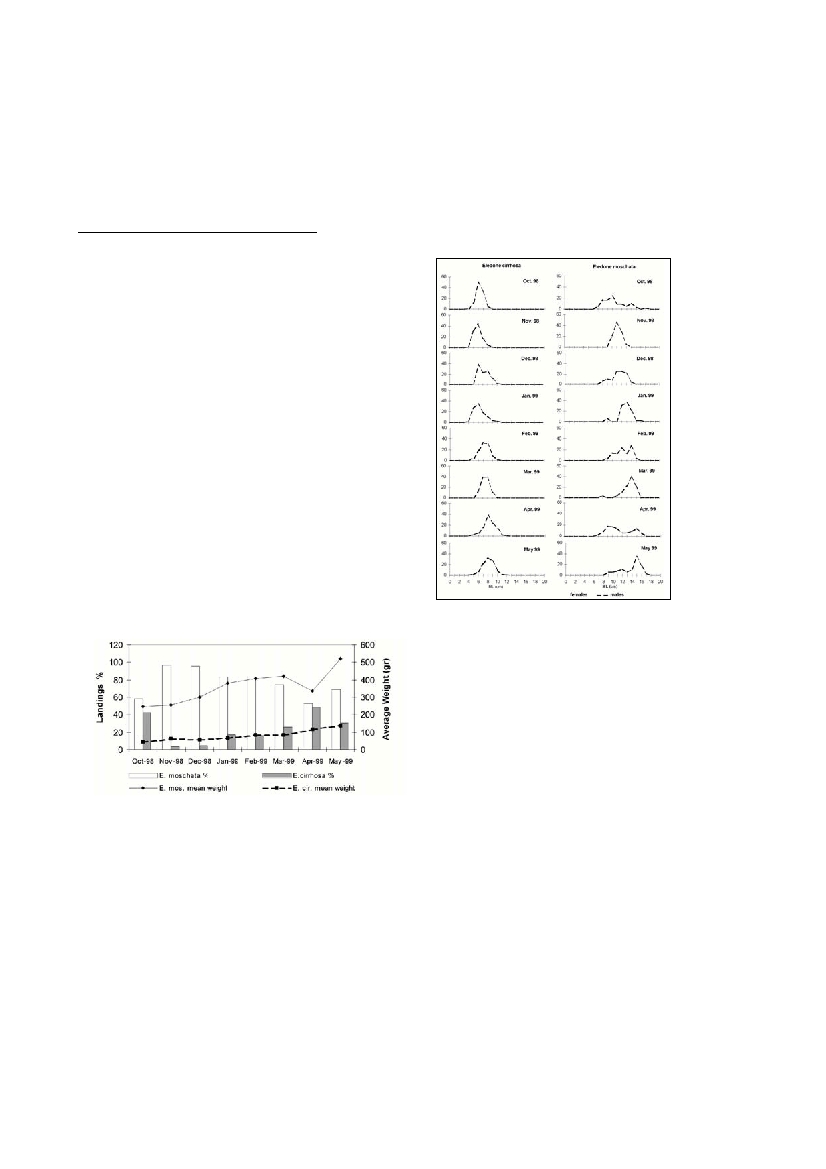Rapp. Comm. int. Mer Médit., 36,2001
294
Introduction
Eledone moschataandEledone cirrhosaare an important component of
cephalopod catches in the Thracian Sea (1). This resource is exploited
almost exclusively by trawlers and less than 1% of Eledone moschatais
landed by beach-seiners (2). Both eledonids, are commercialized under the
same common name, thus it is impossible to assess catches of each species
from official landings.
The monthly contribution of the two species in landings was studied for
the first time in the framework of an E.U. funded project on “Analysis and
evaluation of the fisheries of the most important cephalopod species in the
Mediterranean Sea”.
Materials and methods
Landings of the two species were reported for trawlers on a fortnight
basis (the last three days of each fortnight), by an observer at the auction
of Kavala. The period June-September is a closed season for trawlers
according to the Greek legislation, thus data were collected for the 8month
fishing period : October 1998 - May 1999. During this period biological
samples of trawlers landings were bought every month. Records of mantle
length (in mm), weight (in gr), sex and maturity stage were taken from
freshly caught or frozen specimens.
Results and discussion
E. moschataconstituted the major part (69-96%)of eledonids landings
from November ’98 to March ’99 and in May ’99 (Fig. 1). Experimental
trawl surveys carried out in the Thracian Sea (1992-1993) had shown that
E. moschataandE. cirrhosarepresented respectively the 14.2% and 26.7%
of the cephalopod biomass estimated for the bathymetric zone 10-400m
(1). The dominance of E. moschatain trawl landings could be related to the
small individual weight of immature E. cirrhosaduring the sampling peri-
od, as well as, to the greater concentration of trawlers activity in lower
depths near the coasts, especially in winter time, where E. moschatais
more abundant (1).
Figure 1. Monthly percentage and mean individual weight of E. cirrhosa
andE. moschata in the Thracian Sea from October 1998 to May 1999.
A single cohort is present in E. cirrhosalandings, with a common modal
length for both sexes, increasing from 6cm in October to 8cm in May
(Fig.2). The presence of one year class in the catches of E. cirrhosahas
also been reported for other areas (1,4) and it could be related to the short
life span of the species (about 1 year) (4) and the seasonality in the repro-
ductive cycle of the species (5).
Length frequency distributions indicate two peaks of recruitment for E
.
m
o
s
ch
a
t
a, occuring in October ’98 and April ’99 (Fig. 2). A wide recruitment
period has been shown for E. mosch
a
t
aalso in the southern A
egean Sea (6).
Sexual maturation follows different time courses for the two sexes in
both species. Immature individuals dominate (74% - 100%) in the popula-
tion of E. cirrhosatill March, whereas only males attain maturity within
the sampling period. According to previous investigation in the study area,
it is assumed that the period of female maturity in the Thracian Sea occurs
from early summer till mid of autumn (7).
Mature females of E. moschata(11/98 - 3/99 : 4-14%, 4/99 : 23%, 5/99:
52%) show an apparent increase from April onwards whereas high per-
centages of mature males appear from February (69%). The relatively low
percentage of mature females (31%) in October indicates that these are
probably the last to mature and spawn from a year class which began
spawning in early spring, This suggestion is in agreement with the model
of the species life cycle proposed by Mangold (8).
References
1 - Lefkaditou E. and Papaconstantinou C., 1999. Cephalopod distribution and
fisheries in the Thracian Sea. Meeting of the Geotechnical Chamber of Greece
- Branch of Thrace on “Fish stock management in the Thracian Sea”, May
1999, Proceedings volume : 15-32.
2 - Lefkaditou E. and Adamidou A., 1997. Beach-seine fishery in the Thracian
Sea and its contribution to the exploitation of the demersal species.
Proceedings of the 5
th
Symposium of Fishery and Oceanography, Kavala,
April 1997, Vol. 2.
3 - Boyle P. R. and Knobloch D., 1982. On growth of the octopus Eledone
cirrhosa.J. mar. biol. Ass. U.K., 62 : 277-296.
4 - Wurtz M., Matricardi G. and Belcari P., 1992. Distribution and abundance
ofEledone cirrhosain the Tyrrhenian Sea, Central Mediterranean. Fisheries
Research13 : 53-56.
5 - Boyle P.R.,1983. Eledone cirrhosa. In : P.R. Boyle (Ed.):Cephalopods
Life Cycle. Species Account,Vol. I : 366-385. Academic Press, London.
6 - Lefkaditou E., Siapatis A. and Papaconstantinou C., 1998. Seasonal and
spatial changes in the abundance and distribution of Eledone moschata
(Cephalopoda : Octopoda), in the South Aegean Sea (Eastern Mediterranean).
ICES Doc. CM1998/M: 44 (poster and text): 8 pp, Lisbon, September 1998.
7 - Lefkaditou E. and Papaconstantinou C., 1995. Distribution , growth and
maturity of Eledone cirrhosa(Cephalopoda : Octopoda) in the Thracian Sea
(Eastern Mediterranean). Rapp. Comm. int. Mer Medit.34 : 247.
8 - Mangold K., 1983. Eledone moschata.In: P.R. Boyle (Ed.) :
Cephalopods Life Cycle. Species Account, Vol. I : 387-400. Academic
Press, London.
ELEDONIDS EXPLOITED IN THE THRACIAN SEA:
PRELIMINARYANALYSIS OF STOCK STRUCTURE BASED ON TRAWLERS LANDINGS
E. Lefkaditou
1
*, P. Leondarakis
2
, C. Papaconstantinou
1
and A. Tsangridis
2
1
National Centre for Marine Research, Helliniko, Athens, Greece - teuthis@posidon.ncmr.gr
2
Fisheries Research Institute - N.AG.RE.F., Kavala, Greece
Abstract
Eledone moschataandEledone cirrhosaare by-catches of demersal trawling for fishes in the Thracian Sea. Trawl landings of the two
species were recorded for the fishing period October 1998 - May 1999, during which the proportion of E. moschatawas generally higher.
A single cohort, consisted mostly of immature individuals, was present in E. cirrhosalandings. In the population of E. moschatatwo peaks
of recruitment in October ’98 and April ’99, were observed. Males have been shown to reach maturity earlier than females in both species.
Keywords : Cephalopods, fisheries, Aegean Sea
Figure 2.
Monthly length -
frequency distri-
butions of
E. cirrhosaand
E. moschatain
the Thracian
Sea from
October 1998 to
May 1999.

